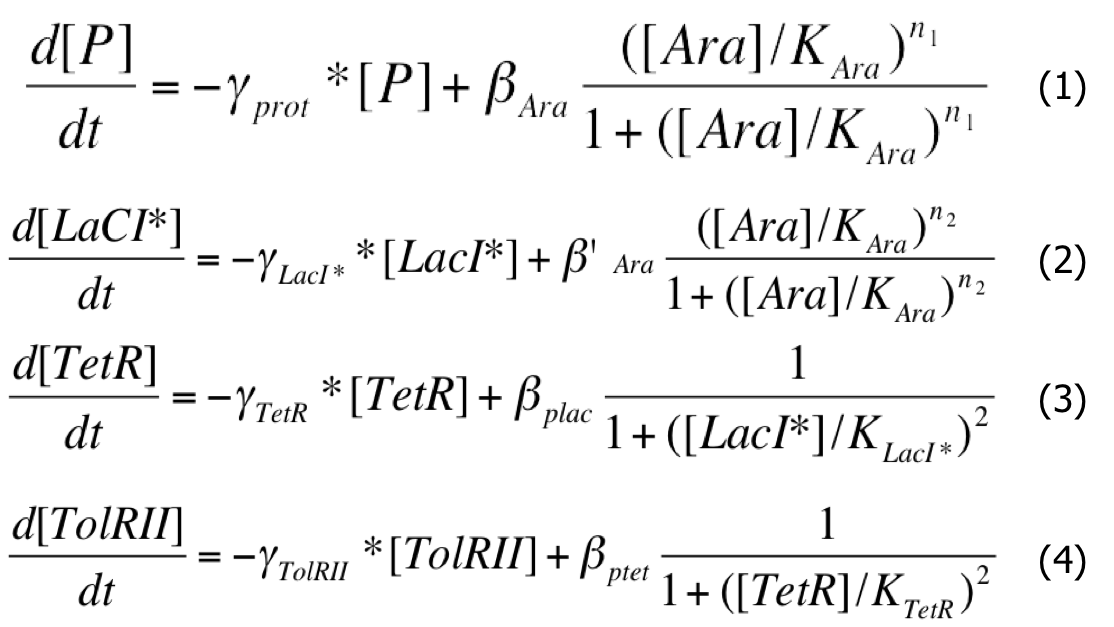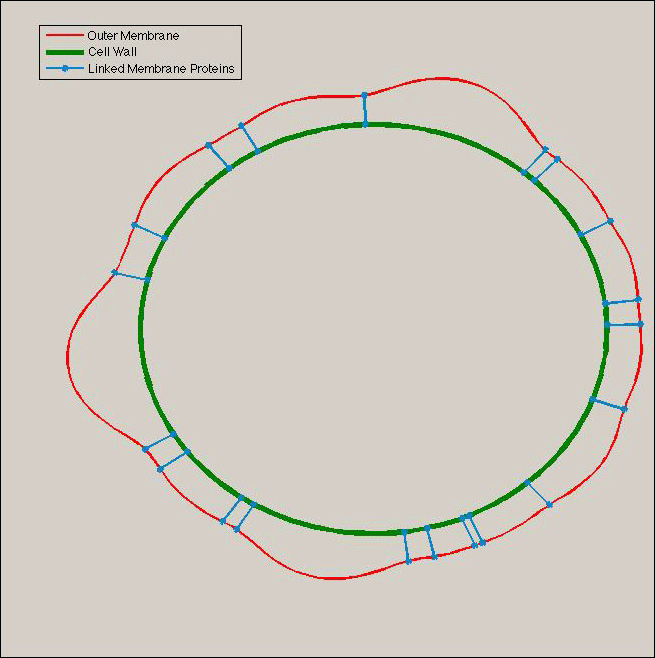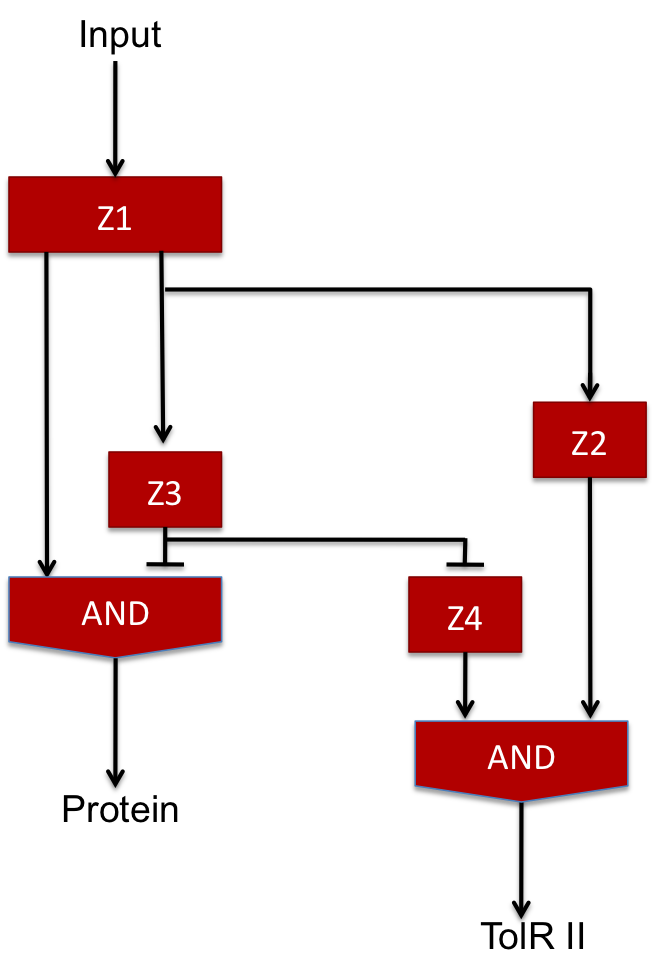Team:Paris/Production modeling
From 2009.igem.org
iGEM > Paris > Production > Modeling
Contents |
Modeling
X
A. Genetic Network Regulation
"The Delay system"
The first thing that we wanted to study in modeling was the efficiency of the construction chosen to create a delay. Our first approach was a deterministic analysis of the system using differential equations. The regulation of promoters was described using the Hill functions and the methods described by U. Alon in his book An Introduction to Systems Biology.
When the system is activated, there is Arabinose in the medium and the pBad promoters are activated. And the system can be described by this system of differential equations :
| Differential System |

|
As a first approximation, we assumed that :
- When the pBad promoter is induced, the concentration of arabinose in the medium is very high and constant during he whole study ; as a consequence, we will consider that the creation rate of Protein and LacI* is constant during the experiment :
- We considered that all the binding constants are identical and of an average of 40nM which correspond to approximately 40 monomers per cell ; we can write that :
- We chose identical intrisinc promoter activities, β , all equal to 4000 proteins/cell cycle :
- All the time units were expressed in units of cell cycle (approximately half an hour) ; as a consequence we chose a dilution rate γ of 1 for protein without special tags. For the Laci protein with a LVA tag, the dilution rate is multiplied by 3:
Incoherent Feedforward
Using the delay system in our genetic regulatory network, we were able to find a way to get a maximum quantity of TolRII when the concentration of exported proteins is at its maximum.
We also have thought of another device designed to have a reaction rate of TolRII production at its higher level when the concentration of exported is at its maximum. To this, end, we decided to combine two feed-forward loops to create a "burst" in the production of each protein.
The two feed-forward loops used are incoherent and agenced in a way that each molecule is either an activator or a repressor (and not both). The following scheme gives the functionning of the system.
The Feed Forward Motif
The feed forward motif was studied and described by U. Alon in his book "An Introduction to Synthetic Biology" where he describes the different form of existing feed forward ; they can be either coherent or incoherent.
In each case, there exist a different network organisation to create a feed-forward loop ; there are all listed on the image .....>IMAGE
Our design proposition
B. Modeling Vesicles creation.
Our model is based on three different physical phenomenon:
- The lipid surface conformation, Tol-Pal proteins diffusion and the increase of the osmotic pressure in the periplasm
- The Lipid conformation of the outer membrane is a well known problem: at 35°c the lipid bilayer behaves like a liquid which conformation character is ruled by an energy called the bending energy. This energy represents the fact that the lipid bilayer will search a special conformation depending on the shape and the chemical properties of its constituents.
- The conformation of the lippopolysaccharides and the normal phospholipids can be seen has a lipid bilayer which conformed itself as a liquid crystal at the growth culture. The conformation of lipid bilayer has been well studied and a lot of theoretical results have been shown. Some of them are of great interest for our project. This conformation is something which can enable us to understand the way vesicle can be produced and how they will be received. In our project we first notice that from a basic calculus we can obtain very interesting results on the way outer membrane vesicles can be produced.
- We first use the bending energy has a rough shape for our model and its understanding:
- This formula give use the abilities to explain the way lipids will organize together. E is the energy of a whole lipid bilayer (or monolayer).Kb and Kg are Bending and Gaussian modulii which can be obtained by experiments. γ0 is the intrinsic curvature of the outer membrane which describes the local form of a lipid bilayer when it is at is lowest state of energy ,the more stable. γm and Hg are the mean curvature and the gaussian curvature. Our first task was to calculate the energy of two different shapes of membranes.
- We compute the E.coli Shape before the division and then the vesicles' shape.
- We consider E.coli's shape as a cylinder of rayon r =0.3 μm and of infinite length. The aim of this first representation was to estimate this energy in the division region of E.coli before division. With this approximation γm is equal to 2/r and γg=0. In this case:
- For the vesicles we consider their basic shape as a sphere of rayon r’ so the bending energy by lipid area units is:
- Thus as the area of a sphere is known and is independent of the location on the sphere we can write: In the same way we can write for an area of E.coli lipids that the bending energy is:
- The considerations aforementioned can provide a basic vision of the statistical repartition of vesicles in case of absence of integrity control system in the outer membrane.
- The first energy is the potential energy of the lipid area in E.coli outer membrane necessary to the construction of a vesicle and the second one the potential energy of the same lipid area but in the conformation of a vesicle shape. So the energy which must be given to the whole system to create a vesicle is:
- We can suppose that the most easily created vesicles will be the ones which requires a minimum energy . By derivation we find that the minimum his obtain for:

|
- Hence as we know that the range of created vesicles radii is 25 nm to 175nm we can suppose that the r’ is somehow about 100 nm and so:
- We can consider the orders of magnitude as really realistic. In fact we know that the E.coli lipid bilayer is built of distinct types of lipids: Lippopolysacharides and simple phospholipids. LPS are located in the exterior lipid layer of the outer membrane. The others are located in the interior lipid bilayer. Moreover, those LPS present a sugar extension toward the medium. Those sugars can bind to each other. So we can assume that they are going to create clusters and to curve the membrane toward the exterior of E.coli.
- Tol and Pal are membrane proteins which are located respectively in the outer and the inner membrane. The diffusion of proteins in those lipid bilayers can be modelled by a probabilistic Brownian movement. This diffusion model gives us the law of probability for the location of Tol and Pal on the membranes. It has been observed that the Tol and Pal proteins interact with each other, which is linked to the membrane stability: indeed the Tol and Pal will bind inner and outer membrane and furthermore stabilize the outer membrane using the peptidoglycan rigidity.
- The osmotic pressure in the periplasm is the same that the medium pressure in normal time. But during the division period of the bacteria the peptidoglycan is degraded to be recycled in a new cell wall. During this phenomena of turn-over a part of the peptidoglycan is released in the periplasm which increased its osmotic pressure.
- Thus, we can consider that if there is not enough Tol-Pal linked proteins the outer membrane will distort to create a beginning of vesicle. But in this part of the membrane the tol pal proteins will not have the possibility to bind themselves and they will be free to diffuse in other parts of the membranes. The surface shape will guide the proteins to the border of the vesicle and stabilized the shape of the vesicle.
- To describe the time variation of the vesicles creation we first have to use a more complicated approach: we need to use an equation which is obtained by derivation of the bending energy:
Ou-Yang and Helfrich [Phys. Rev. Lett. 59 (1987) 2486]
- Our first model which didn't use the brownian movement :
We first conciders that the membrane equation can be first simplified to a one dimentional model :in a first approach we use a one dimensional model based on a polar curvature simplification approximation :

|
 "
"

